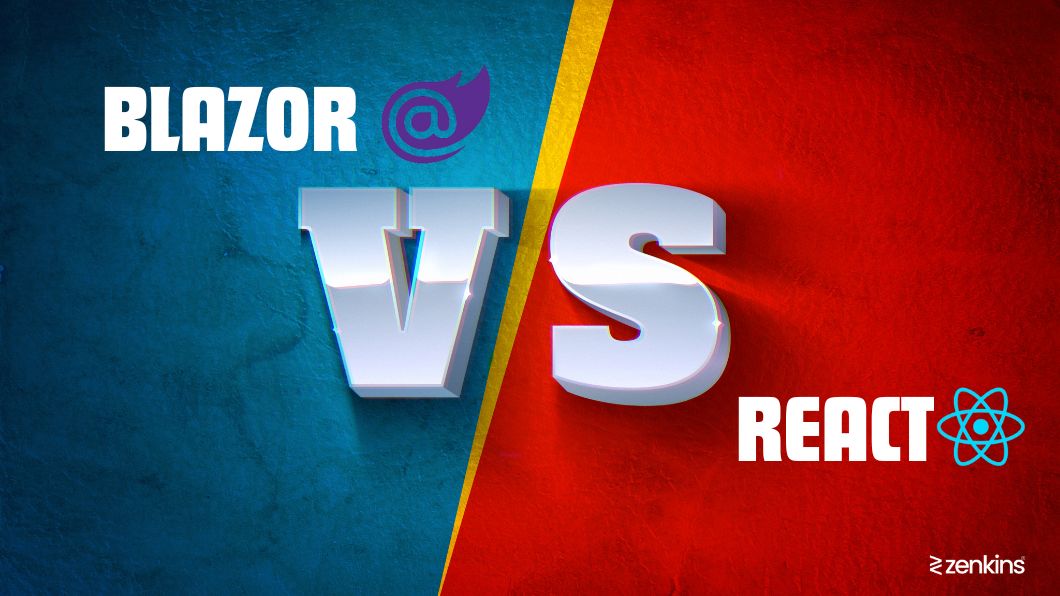Blazor vs. React for Building Modern Web UIs
Table of Contents
Blazor and React are two popular frameworks for building modern web user interfaces (UIs) that offer unique approaches and advantages. Blazor, developed by Microsoft, is an open-source framework that allows developers to build interactive web applications using .NET and C# instead of JavaScript. On the other hand, React, developed by Facebook, is a JavaScript library known for its component-based architecture and efficient rendering.
In this article, we will explore the similarities and differences between Blazor and React, comparing their performance, scalability, UI development approaches, interactive component building, testing and also the debugging capabilities, backend integration options, and the support they receive from their respective communities. By the end, you will have a better understanding of which framework might be the right choice for your next frontend project.
Introduction to Blazor vs. React
What is Blazor?
Blazor, for those who haven’t heard of it, is a new and exciting framework for building web applications. Developed by Microsoft, Blazor allows you to write frontend code in C# and run it directly in the browser using WebAssembly. No more juggling between multiple languages and frameworks – with Blazor, you can use your existing C# skills to build modern web UIs.
What is React?
React, on the other hand, is a widely popular JavaScript library for building user interfaces. Developed by Facebook, React has gained a massive following thanks to its component-based architecture and efficient rendering. With React, you can create reusable UI components and efficiently update only the necessary parts of your UI when data changes.
Comparing Blazor and React: Performance and Scalability
Performance benchmarks of Blazor
Blazor’s performance has come a long way since its early days. Thanks to advancements in WebAssembly and the optimization efforts by the Blazor team, you can now achieve near-native performance with Blazor. However, it’s important to consider the size of the WebAssembly package that needs to be downloaded by the client, as larger packages can affect the initial load time.
Performance benchmarks of React
React’s performance is one of its strongest suits. Its virtual DOM and intelligent diffing algorithms ensure that only the necessary changes are applied to the UI, resulting in lightning-fast updates. React’s ecosystem also offers various performance-enhancing tools and techniques, making it a top choice for highly performant applications.
Scalability considerations for Blazor
As Blazor is relatively new, the ecosystem is still growing. However, with its ability to reuse existing .NET libraries and components, Blazor can leverage the vast .NET ecosystem, providing a solid foundation for building scalable applications. Additionally, Blazor’s component-based architecture makes it easy to modularize your code, promoting reusability and maintainability.
Scalability considerations for React
React’s popularity and vast ecosystem make it a go-to choice for building scalable applications. With tools like Redux and React Router, managing state and routing in larger applications becomes a breeze. React’s component-based approach also promotes scalability by encouraging code reuse and separation of concerns.
Click here for .NET Development services!
User Interface Development: Blazor vs. React
Overview of UI development in Blazor
In Blazor, UI development is done using a combination of C# and Razor syntax. You can create reusable components that encapsulate both the UI markup and the associated logic, making it easy to maintain and test your code. Blazor also provides a rich set of built-in components and layout features, allowing you to quickly create beautiful and responsive user interfaces.
Overview of UI development in React
React takes a different approach to UI development. It uses JSX, a syntax extension that allows you to write HTML-like code within JavaScript. This combination of HTML and JavaScript makes it easy to create reusable components and compose them to build complex user interfaces. With React, you have fine-grained control over the rendering and lifecycle of your components.
Differences in UI development approach
While both Blazor and React enable you to build reusable UI components, the difference lies in the languages and syntax used. Blazor offers the familiarity of C# and Razor, which can be advantageous if you’re already proficient in these technologies. React, on the other hand, leverages JavaScript and JSX, which are widely used in the frontend community. The choice ultimately depends on your preferences and existing skillset.
Building Interactive Components: Blazor vs. React
Creating interactive components in Blazor
In Blazor, creating interactive components is a breeze. You can handle user interactions and events directly in your C# code, thanks to its tight integration with the browser’s event system. Blazor’s event handling and data binding capabilities make it easy to build interactive and responsive UIs without writing a lot of boilerplate code.
Creating interactive components in React
React’s approach to handling interactivity is centered around managing component state. By keeping track of state within components, you can update the UI based on user interactions. React’s declarative nature and one-way data flow make it straightforward to manage state and create interactive components. Additionally, React provides hooks, a powerful feature that simplifies state management and side effects.
Comparison of interactivity features
Both Blazor and React offer robust features for creating interactive components. Blazor’s integration with C# and its event handling capabilities provide a smooth and familiar development experience. React, on the other hand, excels in managing component state and provides a rich ecosystem of state management solutions. Ultimately, the choice between Blazor and React for interactivity depends on your development preferences and the specific requirements of your project.
Testing and Debugging: Blazor vs. React
Testing strategies for Blazor
Testing is a crucial part of any development process, and Blazor provides developers with a range of options for testing their applications. You can write unit tests using popular testing frameworks like Xunit and NUnit. Blazor also supports end-to-end testing using tools like Selenium or Cypress, allowing you to simulate user interactions and ensure your application behaves as expected. With Blazor’s tight integration with .NET, you can also leverage existing testing tools and practices from the wider .NET ecosystem.
Testing strategies for React
Just like Blazor, React offers various testing strategies to help developers verify the correctness of their applications. React has its own testing library called React Testing Library, which provides a simple and intuitive interface for testing React components. Additionally, React can be integrated with popular testing frameworks like Jest, allowing you to write unit tests and perform snapshot testing. React’s vibrant community also offers a wide range of third-party testing libraries and tools to suit different project requirements.
Debugging tools and techniques in Blazor
When it comes to debugging, Blazor provides excellent support through browser developer tools. You can use the browser’s built-in debugging tools, such as Chrome DevTools or Firefox Developer Tools, to inspect and debug your Blazor application. Blazor also integrates with Visual Studio, offering a seamless debugging experience within the IDE. Visual Studio allows you to set breakpoints, step through code, inspect variables, and diagnose issues efficiently.
Debugging tools and techniques in React
React developers also have access to powerful debugging tools to track down those pesky bugs. Modern browsers have built-in developer tools that allow you to inspect and debug React applications. You can use these tools to analyze component hierarchies, monitor component state, and diagnose performance bottlenecks. Additionally, popular code editors like Visual Studio Code provide extensions that enhance the debugging experience for React developers, making it easier to identify and fix issues effectively.
Integrating with Backend Systems: Blazor vs. React
Backend integration in Blazor
Blazor’s backend integration story is deeply tied to the .NET ecosystem. As a developer, you can seamlessly integrate Blazor with backend systems using technologies like ASP.NET Core. With Blazor, you have access to the extensive capabilities of .NET, including powerful data access libraries, authentication and authorization frameworks, and REST API integrations. This tight integration simplifies the process of connecting your frontend with backend services, making it easier to build robust and scalable applications.
Backend integration in React
React, being a framework-agnostic library, does not prescribe any specific backend integration approach. As a React developer, you have the flexibility to choose from a wide range of backend technologies to suit your project requirements. Whether you prefer to use REST APIs, GraphQL, or WebSocket connections, React can seamlessly integrate with any backend system. This flexibility allows you to leverage existing backend infrastructure or adopt new technologies without being tied to a specific ecosystem.
Comparison of backend integration approaches
When comparing backend integration approaches between Blazor and React, it’s important to consider the trade-offs. Blazor’s tight integration with .NET provides a cohesive development experience, leveraging the powerful capabilities of the .NET ecosystem. React, on the other hand, offers flexibility and allows developers to choose the backend technology stack that best suits their needs. It ultimately depends on the project requirements, existing infrastructure, and the specific preferences of the development team.
Community and Ecosystem Support for Blazor and React
Availability of third-party libraries and components in Blazor
Blazor, being a relatively newer framework, is rapidly growing its ecosystem. While it may not have the same vast library support as React, it offers a growing collection of third-party libraries and components. The Blazor community actively contributes to open-source projects, creating extensions, UI frameworks, and other reusable components that can be easily integrated into your applications. Although the choices are still expanding, Blazor’s ecosystem is maturing quickly, providing developers with more options as time goes on.
Availability of third-party libraries and components in React
React boasts a mature and thriving ecosystem with an extensive range of third-party libraries and components. The React community actively develops and maintains countless libraries and UI frameworks that can significantly boost your productivity. Whether you need a date picker, a charting library, or a complete UI toolkit, chances are there’s already a well-established solution available for React. This rich ecosystem ensures that developers have access to a vast pool of resources that can be easily integrated into their projects.
Support and community resources for Blazor
As Blazor gains popularity, its support and community resources continue to grow. Microsoft provides official documentation, tutorials, and a dedicated community forum to help developers get started with and troubleshoot any issues they may encounter while working with Blazor. Additionally, the open-source nature of Blazor fosters active community engagement, with developers sharing their experiences, best practices, and code samples on platforms like GitHub and Stack Overflow.
Support and community resources for React
React’s extensive adoption and mature ecosystem ensure a wealth of support and community resources. The official React documentation is comprehensive and beginner-friendly, covering everything from basic concepts to advanced topics. The React community is highly active, with numerous online forums, discussion groups, and social media channels where developers can seek help, share knowledge, and collaborate. Whether you prefer video tutorials, articles, or interactive courses, you’ll find an abundance of resources tailored to help you excel in React development.
Conclusion: Choosing the Right Framework for Your Project
Choosing the right framework for your project ultimately depends on your specific requirements, team expertise, and project constraints. Blazor offers the advantage of tight integration with .NET, allowing developers to leverage existing skills and infrastructure. On the other hand, React provides a flexible and widely-supported solution, offering a mature ecosystem and endless possibilities for backend integration. Whichever framework you choose, rest assured that both Blazor and React have active communities and abundant resources to support your frontend development journey. So, dive in, explore the options, and embark on your frontend frenzy with confidence!
Both Blazor and React offer powerful capabilities for building modern web UIs. Blazor provides the advantage of using C# and .NET, allowing developers to leverage their existing skills and tools. React, on the other hand, has a vast ecosystem and a mature community that continually contribute to its growth. When deciding between Blazor and React, it is crucial to consider factors such as performance, scalability, development approach, testing and debugging capabilities, backend integration, and community support. Ultimately, the choice depends on your project requirements, team expertise, and long-term goals. By thoroughly evaluating these aspects, you can make an informed decision and confidently select the framework that will help you deliver exceptional web UI experiences.
Now that you have a better understanding of Blazor and React, it’s time to dive deeper and explore which framework is the right fit for your next front-end adventure. Happy coding!
FAQ
Can I use Blazor with existing JavaScript libraries and frameworks?
Yes, Blazor supports interoperability with JavaScript libraries and frameworks through a feature called JavaScript Interop. This allows you to seamlessly integrate existing JavaScript code into your Blazor applications, enabling you to leverage the functionality provided by popular JavaScript libraries like jQuery, D3.js, and more. With Blazor’s JavaScript Interop, you can combine the power of C# and .NET with the flexibility of JavaScript libraries.
Is React more suitable for building large-scale applications compared to Blazor?
Both Blazor and React can be used to build large-scale applications, but they have different approaches and considerations. React’s component-based architecture, virtual DOM, and extensive ecosystem make it a popular choice for large-scale applications. However, Blazor’s use of .NET and C# can provide advantages for teams already experienced with these technologies, and its server-side rendering allows for efficient usage of server resources. The choice between Blazor and React for large-scale applications depends on factors such as project requirements, team skillsets, and performance needs.
Which framework, Blazor or React, has better community support?
Both Blazor and React have active and supportive communities. React, being developed and maintained by Facebook, has a larger and more established community with a wealth of resources, libraries, and community-driven initiatives. Blazor, while relatively newer, has been gaining popularity, and its community is growing rapidly. Microsoft provides official documentation, tutorials, and community forums for Blazor, and third-party libraries and components are also emerging. Ultimately, the level of community support for each framework is constantly evolving, and it is recommended to assess the available resources and community engagement when considering the framework for your project.






